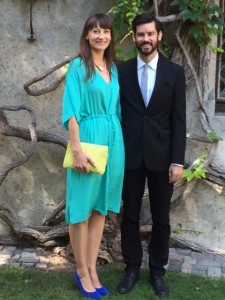Questions or Answers?

Question or answer?
Which is more important: questions or answers?
Being a good systems thinker, I used to think the answer was obvious: answers are more important than questions. You’re given a problem, you pull it apart into its subsystems, you analyze them, and you develop solutions.
But what if you’re analyzing the wrong problem?
I thought about this yesterday when I read a profile of Alejandro Aravena, the Chilean architect who just won the Pritzker Prize. Aravena and his colleagues – as you might imagine – develop some very creative ideas. They do so by focusing on questions rather than answers. (Aravena’s building at the Universidad Católica de Chile is pictured).
In 2010, for instance, Aravena’s firm, Elemental, was selected to help rebuild the city of Constitución after it was hit by an earthquake and tsunami. I would have thought that they would focus on the built environment – buildings, infrastructure, and so on. They’re architects, after all. Isn’t that what architects do?
But Aravena explains it differently:
“We asked the community to identify not the answer, but what was the question,” Mr. Aravena said. This, it turned out, was how to manage rainfall, so the firm designed a forest that could help prevent flooding.
Architects, then, designed a forest instead of a building. If they were thinking about answers rather than questions, they might have missed this altogether.
On a smaller scale, I had a similar experience early in my career when I worked for Solbourne Computer. We build very fast computers – in 1988, Electronics magazine named our high-end machine the computer of the year. Naturally, we positioned our messages around speed, advanced technology, and throughput.
But our early customers were actually buying something else. When we interviewed our first dozen customers, we found that they were all men, in their early thirties, and that they had recently been promoted to replace an executive who had been in place for many years. They bought our computers to mark the changeover from the old regime to the new regime. They were meeting a sociological need as much as a technical need.
When you go to a gas station to fill your car’s tank, you may imagine that you’re buying gasoline. But, as the marketing guru Ted Levitt pointed out long ago, you’re really buying the right to continue driving your car. It’s a different question and a broader perspective and may well lead you to more creative ways to continue driving.
More recently, another marketing guru, Daniel Pink, wrote that products and services “… are far more valuable when your prospect is mistaken, confused or completely clueless about their true problem.” So often our market research focuses on simple questions about obvious problems. The classic question is, “What keeps you up at night?” We identify an obvious problem and then propose a solution. Meanwhile, our competitors are identifying the same problem and proposing their solutions. We’re locked into the same problem space.
But if we step back, look around, dig a little deeper, observe more creatively, and ask non-obvious questions, we may find that the customer actually needs something completely different. Different than what they imagined – or we imagined or our competitors imagined. They may, in fact, need a forest not a building.
Designing Minds

Designers.
I learned systems analysis in graduate school. I know how to use analytic tools to break a problem apart and fix the component parts. That is, I know how to use the tools if and only if I know that a problem exists. In most cases, somebody has to describe the problem to me.
Julia and Elliot, our son and daughter-in-law, learned design thinking in graduate school. They know how to observe closely and intuit what users need. They empathize and can see the world from the user’s perspective. They know how to suspend their assumptions and see the world as it is, not as it’s assumed to be. Paraphrasing Picasso, they see with their eyes, not their minds.
They also have the skills, of course, to design solutions to meet the user’s needs. They can even design solutions for problems that weren’t apparent to the user. Because of the way they observe the world, Julia and Elliot can identify problems and needs that I can’t.
Businesses are starting to realize that design thinking holds significant advantages over traditional methods of systems analysis. Design thinking is an observational skill as much as an analytical skill. It uses empathy and imagination to understand the world at a deeper level and design unexpected solutions.
What does it mean to be design-driven? McKinsey gives a simple definition: “…it’s a way of thinking: a creative process that spans entire organizations, driven by the desire to better understand and meet consumer needs.” For me, it’s not only a way of thinking but also a way of seeing. Designers see what the customer really needs, even if the customer doesn’t.
In this regard, design thinking seems similar to the art of negotiation. A successful negotiator sees what the other side needs — even when the other side doesn’t. The negotiator negotiates to that need. The designer designs to it.
In another article, McKinsey expands the definition and states a key benefit: “A design-driven organization is always thinking about its customers, empathizing with end users, and trying to solve problems while keeping its customers in mind. … Companies that have placed design at the center of the organization perform better.” (Italics added).
Design, in other words, provides a competitive edge. When I was fresh out of school, systems thinking was a competitive weapon. Today, it’s design thinking. Design used to be about things, objects, and spaces. Today, it can equally be used to create business processes and services.
The business world seems to be making a fundamental transition from analysis to design. Instead of decomposing a problem, innovative businesses are using imagination and empathy to create solutions. Julia and Elliot, in other words, have positioned themselves at the leading edge of a transformational new wave. What a great time to be young.
Observation and Innovation

Don’t be cowed.
In the mid-1790s, an English country doctor named Edward Jenner made a rather routine observation: milkmaids don’t get smallpox. Milkmaids were often exposed to cowpox, a disease that’s related to smallpox but much less deadly. Cowpox gave the milkmaids flu-like symptoms that were distressing but certainly not lethal. Jenner guessed that the cowpox also conferred immunity to smallpox.
Jenner wasn’t the first to observe the cowpox effect but he was the first in the western world to act on his hunch. He created a vaccine from the scraping of cowpox pustules and administered it to some two-dozen people. They all acquired the immunity to smallpox. Jenner conducted experiments to demonstrate the treatment’s efficacy as well as the biological mechanisms in play. As a result, he is often described as the father of modern immunology.
Jenner’s breakthrough came from simple observation. He paid close attention to the world around him, observed an anomaly, and acted on it. Observation provides a foundation for both critical thinking and innovation. If necessity is the mother of invention, then observation is the grandmother. One has to observe the necessity in order to address it. (If a necessity happens in the forest and no one observes it, is it really necessary?)
How does one learn to be a good observer? Interestingly, most critical thinking textbooks don’t address this. Rather, they teach readers how to ask insightful, clarifying questions. That’s useful, of course, but also somewhat limited. Observation is merely a continuation of questioning by other means. Much more than questioning, observation can reveal fundamental insights that produce important innovations – like Jenner’s.
How does one become a good observer? Here are some thoughts I’ve gleaned from reading and from my own experience.
Pay attention – this may seem obvious but it’s hard to do. We’ve all had the experience of driving somewhere and not remembering how we got there. The mind wanders. What to do? Remind yourself to stay in the moment. Make mental notes. Ask yourself why questions. Mindfulness training may help.
Keep a journal – you can’t observe everything a given moment. Observations grow and change over time. You may have half a good idea today. The other half may not occur to you for years. Steve Johnson calls it a slow hunch. The trick to a slow hunch is remembering the first half. If it’s written down, it’s much easier to recall. (Indeed, one of the reasons I write this blog is to remember what I’ve learned).
Slow down – it’s much easier to think clearly and observe effectively if you take your time. The pace of change may well be accelerating but accelerating your thinking is not going to help you.
Pay attention to System 1 – your fast, automatic system knows what the world is supposed to be like. It can alert you to anomalies that System 2 doesn’t recognize.
Enhance your chance by broadening your horizons – Pasteur said, “Chance favors only the prepared mind.” You can prepare your mind by reading widely and by interacting with people who have completely different experiences than yours. Diversity counts.
Look for problems/listen to complaints – if a person is having a problem with something, it creates an opportunity to fix it.
Test your hypothesis – in other words, do something. Your hypothesis may be wrong but you’ll almost certainly learn something by testing it.
Observing is not always easy but it is a skill that can be learned. Many of the people we call geniuses are often superb observers more than anything else. Like Edward Jenner.
Postscript – Jenner inoculated his first patient in May 1796. Once Jenner showed its efficacy, the treatment spread quickly. So did opposition to it. In 1802, James Gillray, a popular English caricaturist, created the illustration above. Opponents claimed that cows would grow out of the bodies of people who received cowpox vaccines. Anti-vaccine agitation has been entwined with public health initiatives since the very beginning.
Seeing And Observing Sherlock

Pardon me while I unitask.
I’m reading a delightful book by Maria Konnikova, titled Mastermind: How To Think Like Sherlock Holmes. It covers much of the same territory as other books I’ve read on thinking, deducing, and questioning but it reads more like … well, like a detective novel. In other words, it’s fun.
In the past, I’ve covered Daniel Kahneman’s book, Thinking Fast and Slow. Kahneman argues that we have two thinking systems. System 1 is fast and automatic and always on. We make millions of decisions each day but don’t think about the vast majority of them; System 1 handles them. System 1 is right most of the time but not always. It uses rules of thumb and makes common errors (which I’ve cataloged here, here, here, and here).
System 1 can also invoke System 2 – the system we think of when we think of thinking. System 2 is where we logically process data, make deductions, and reach conclusions. It’s very energy intensive. Thinking is tiring, which is why we often try to avoid it. Better to let System 1 handle it without much conscious thought.
Kahneman illustrates the differences between System 1 and System 2. Konnikova covers some of the same territory but with slightly different terminology. Konnikova renames System 1 as System Watson and System 2 as System Holmes. Konnikova proceeds to analyze System Holmes and reveal what makes it so effective.
Though I’m only a quarter of the way through the book, I’ve already gleaned a few interesting tidbits, such as these:
Motivation counts – motivated thinkers are more likely to invoke System Holmes. Less motivated thinkers are willing to let System Watson carry the day. Konnikova points out that thinking is hard work. (Kahneman makes the same point repeatedly). Motivation helps you tackle the work.
Unitasking trumps multitasking – Thinking is hard work. Thinking about multiple things simultaneously is extremely hard work. Indeed, it’s virtually impossible. Konnikova notes that Holmes is very good at one essential skill: sitting still. (Pascal once remarked that, “All of man’s problems stem from his inability to sit still in a room.” Holmes seems to have solved that problem).
Your brain attic needs a spring cleaning – we all have lots of stuff in our brain attics and – like the attics in our houses – a lot of it is not worth keeping. Holmes keeps only what he needs to do the job that motivates him.
Observing is different than seeing – Watson sees. Holmes observes. Exactly how he observes is a complex process that I’ll report on in future posts.
Don’t worry. I’m on the case.